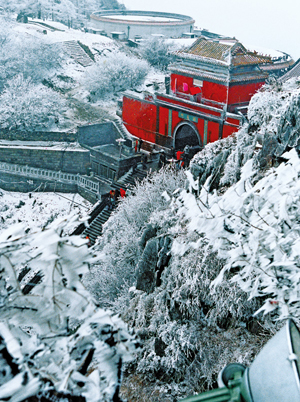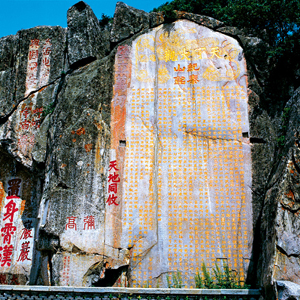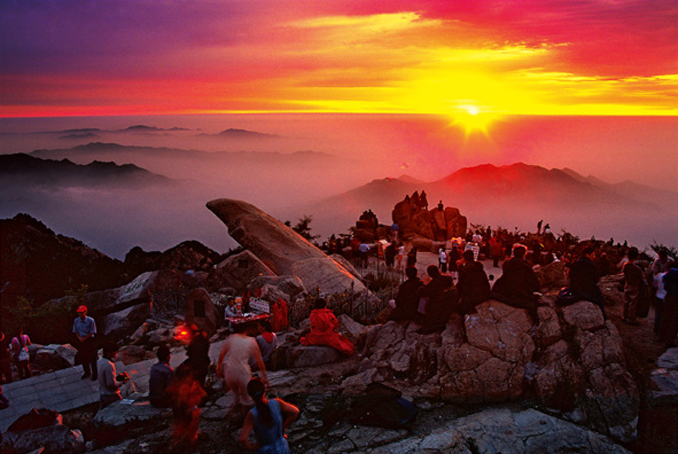Written by: Feng Yang
Posted on: July 02, 2013 | 
Heavenly Gate at Mount Taishan
Mount Taishan is so famous in China that it is regarded as the most sacred and most magnificent of the five sacred mountains of the coutry, even though it is only the third highest of them. As many writers and poets acknowledge, Mount Taishan is beyond description, given its size and the numerous sites of historical and cultural interest on it. Meanwhile, they attribute its fame to both divine and human efforts. By "divine efforts", they refer to the strength of nature.
 |
| Southern Heavenly Gate in the snow |
Rising majestically from a vast expanse of a plain in central Shandong Province in East China, the mountain stretches more than 200 kilometers from the east to the west and covers an area of 426 square kilometers. Looked at from afar, the mountain, which has a broad base, sits there quietly, giving viewers an impression of steadiness and heaviness. No wonder there are Chinese proverbs like "as steadfast as Mount Taishan". In terms of elevation, its main peak, the Jade Emperor Peak, is just 1,545 meters above sea level. Located in the east of the North China plain, Mount Taishan is surrounded by hills with a plain of several hundred square kilometers immediately beyond. Ancient people had inscriptions carved on a rock of the mountain, describing it as "stretching as far as the horizon of the heaven, thrusting as high as the sky." Mount Taishan is so imposing, so awe inspiring, that 2,500 years ago an anonymous poet wrote of it, "Wherever they are, people in the state of Lu always have a full view of Mount Taishan."
Granite rocks are said to be the bones and muscles of Mount Taishan, and pine trees, its soul, which combine to add sacredness to the mountain. The pine trees are many centuries old, but are strong and verdant. When wind sweeps through the forest, the pine trees sigh. When walking in the mountain trails in Autumn, one sees trails covered with golden pine needles while clouds float above. Tranquility permeates the entire mountain, occasionally broken by the singing of birds and the sighing of the wind through the forest. Many pine trees have struggled themselves out of rock crevices and are strange looking. Together with the rocks and the mountain itself, the pine trees present a unique landscape of its own.
Imposing as it is, Mount Taishan is beautiful with precipitous cliffs and deep gullies. From its top, people can have a full view of the sun rising from the Yellow River far beyond the horizon and sinking into it.
Beside its scenic beauty, Mount Taishan tops the list of the five sacred mountains for a wealth of cultural relics on it.
 |
| The Carved Stone of Mount Taishan |
In the year 219 BC, Emperor Shihuang, the first emperor of the Qin Dynasty, the first dynasty to rule a unified China, climbed to the top of Mount Taishan. He had an altar built with earth to offer sacrifices to Heaven, at a ceremony he chose to call "feng". Then he descended the mountain, and had another altar built on a small hill to offer sacrifices to Earth, at a ceremony he called "shan". He did this to express his gratitude to Heaven and Earth and pray for consolidation of his dynasty. These imperial ceremonies, which made Mount Taishan special in status, were to be repeated in all dynasties after the Qin.
In the year 110 BC, Emperor Wu of the Western Han Dynasty (206 BC -220 AD) climbed up Mount Taishan for the first time, and he came seven times in the following 22 years. Standing on a top of the highest peak of Mount Taishan, so say historical records, the emperor claimed: "So high, the highest; so large, the largest; so great, the greatest, about which I am so surprised!"
Under an established feudal rule, the thanks-giving ceremonies known as "feng" and "shan" could be held only when the country was unified and in peace, or after auspicious omens were observed. However, some good-for-nothing emperors defied the rule and went to the mountain for worshipping all the same. Emperor Zhenzong of the Song Dynasty (960-1279 AD) was one of them. He ordered a "heavenly book" concocted in 1008, saying that Heaven had bestowed the imperial crown upon him and would protect the dynasty forever. He had the "heavenly book", so to speak, displayed at a ceremony for worshipping of the mountain. The true fact is that the country was chaotic under his reign. The ceremony was the last personally attended by an emperor in honor of Mount Taishan. Emperors of the later dynasties just sent their envoys to the mountain to offer sacrifices to the God of Mount Taishan. However, Heaven worshipping continued at the Temple of Heaven in Beijing as in the case of Ming and Qing dynasties, spanning more than 500 years until China became a republic in 1911. Some emperors took a special liking of Mount Taishan. Emperor Qianlong (1711-1799) of the Qing Dynasty (1644-1911), for example, went to Mount Taishan six times during his life. It was not easy for the emperors to climb more than 10 kilometers from the foot of the mountain to its peak, which usually takes about five hours. Most of them sat in sedan chairs and were carried up the mountain.
There are three gates along the mountain path, which were designed in accordance with the mountain faults. They are named the Heavenly Gate, Middle Heavenly Gate and Southern Heavenly Gate.
Daizong Archway is the entrance and also the starting point of the journey up the mountain. From the archway, one has to climb a total of 6,200 stairs to reach the Southern Heavenly Gate. The slope is increasingly steep as one climbs up, then becomes relatively easy to scale, but is then difficult again. The mountain seems to have a rhythm of its own like waves in the sea. The section from the Heavenly Gate to the Middle Heavenly Gate is the first "wave", and the rest section to the Southern Heavenly Gate, the second "wave". After passing the Southern Heavenly Gate, one reaches the top of the mountain, which is 0.6 square kilometers in area. It is a breath-taking journey for climbers, so difficult that people call it a "journey to Heaven."
From time to time, climbers can see buildings along the mountain path, where sacrificial ceremonies were held. The most important of these is the Temple of Mount Taishan, the venue of the imperial ceremony for worshipping of Earth, where the emperor would stay for the night after the ceremony. The temple used to occupy a quarter of the Tai'an City. It is in fact a palace complex -- one of three in China, the other two being the Forbidden City in Beijing and the Confucius Temple in Qufu. Besides, there are also Taoist and Buddhist temples on Mount Taishan, as well as temples where folk deities are worshipped. Of these, the most in number are the Taoist temples.
 |
| At sunrise |
Emperors came here limited in numbers. In contrast, countless pilgrims, tourists and hermits have been here year after year over the past two thousand years and more, giving birth to Tai'an City at the foot of the mountain. Ancient people did not consider climbing a mountain an adventure, and neither did they take pleasure in conquering a mountain like we do today. In most cases, climbing a mountain was a cultural mission. Once on the mountain, they would enjoy the sight of the peaks, streams, trees and birds there with artistic concern and, inspired, many would write poems or prose. On Mount Taishan, such poems and prose can often been seen carved or painted on cliffs or rocks, and many are in fact excellent calligraphic works.
In 1987, Mount Taishan became a site of the World Cultural Heritage and the World Natural Heritage.
You may also like: